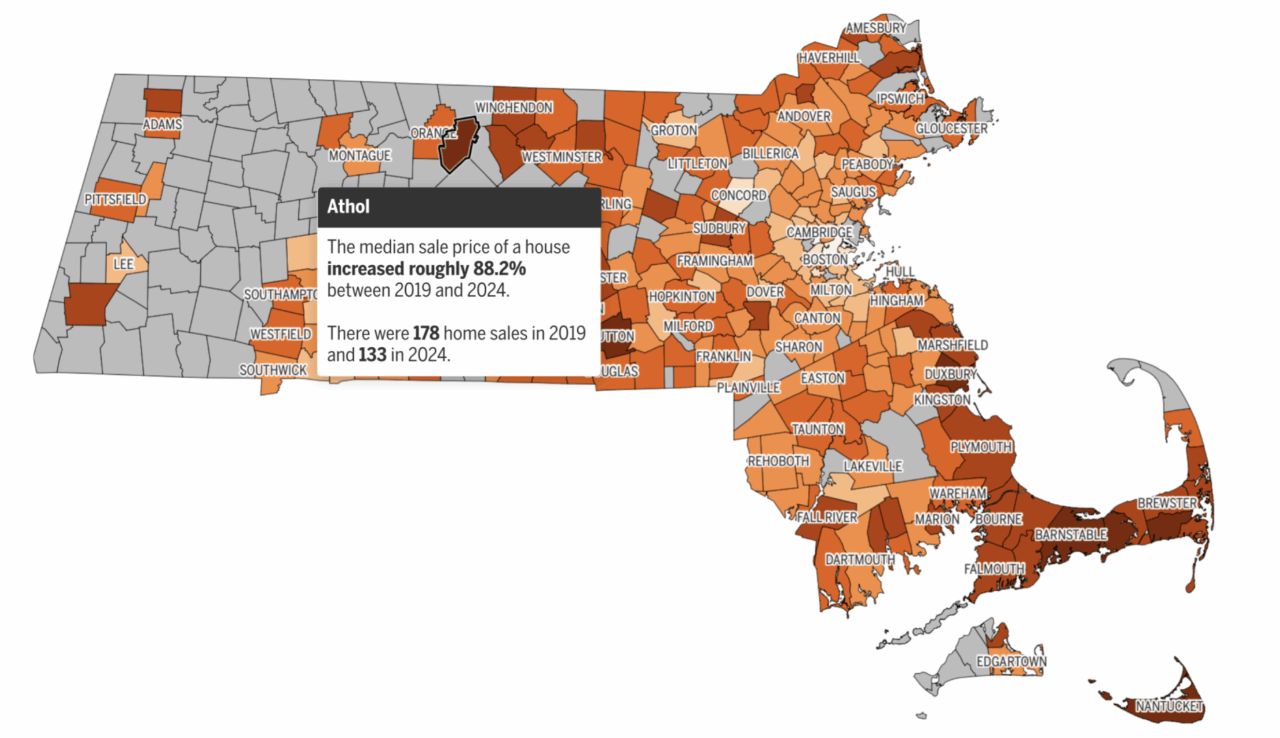
Home prices have continued to rise across the state over the past five years, but popular destinations for warm beach days have been on a blazing hot streak.
Communities on Cape Cod, Martha’s Vineyard, and Nantucket top the list of places where median sale prices for single-family homes have soared the most, according to data from The Warren Group, a real estate information firm. Coastal regions are home to 13 of the 20 towns with the sharpest growth in prices between 2019 and 2024, when looking at places with 50 or more sales in 2024.
Topping the list are Cotuit and Osterville, charming and relatively non-touristy villages within the town of Barnstable. In both villages, the median price of a single-family home more than doubled over the past five years, hitting $907,500 in Cotuit and $1.2 million in Osterville.
Rising prices have hit less high-end coastal towns as well: Dennis, Yarmouth, and the Barnstable villages of Hyannis and Marstons Mills all saw notable increases. In each of those communities, however, the median sale price is still below $700,000, which might even qualify as a bargain in the Cape’s real estate environment.
On Nantucket, the median home sale came in at more than $2.8 million last year. It’s hard to believe, but prices on the island keep getting more expensive: Nantucket saw an 87.5 percent increase in its median sale price, compared with five years ago.

The story of coastal Massachusetts real estate exemplifies the recent dynamics of the state as a whole. Prices began their steep ascent during a market frenzy in 2020, when COVID lockdowns prompted people to look for a little room to breathe while they were stuck at home. Mortgage rates below 4 percent helped even a big purchase make financial sense, says Todd Machnik, president of the Cape Cod and Islands Association of Realtors. Then, even when lockdowns loosened, prices remained stubbornly high because of a lack of supply, Machnik says. There is little new housing being built in the region, and interest rates that have been stuck above 6 percent since fall of 2022 have made homeowners reluctant to list their properties and look for others.
“There was really no way to replenish the inventory,” Machnik says. Of course, surging prices aren’t limited to the Cape and Islands, as other high increases are spread out across the state. Many of these are towns with lower prices that have gained popularity as buyers seek out affordable options in a market that has flummoxed many would-be homeowners. In rural Athol, the median price was $320,000 last year, up more than 88 percent from five years earlier. Prices in the former factory cities of Lawrence and Springfield, meanwhile, rose nearly 70 percent, landing at medians of $500,000 and $280,000, respectively.
Current conditions suggest high prices aren’t going away. In some Massachusetts places, prices continued to climb sharply last year. Seven towns — from Monson out toward the west to Merrimac in the northeastern corner — saw a bump of over 20 percent between 2023 and 2024. In Medfield, Newburyport, and Norwell, the median home price crossed the $1 million mark for the first time last year.
At the same time, market conditions do not seem to augur widespread price drops. In March, there was only 1.4 months’ worth of housing inventory on sale across the state, according to the Massachusetts Association of Realtors. Anything less than a six-month supply is widely understood to tip the market to sellers’ highly-priced advantage.
For some Massachusetts communities, however, the trend of annual price increases surprisingly reversed in 2024. In 33 communities, the median price fell in 2024 compared with 2023, dropping anywhere from 0.1 percent in Lexington to 12.7 percent in Lynnfield. These declines could be an early signal of a more even future for home prices, says Sarah Gustafson, president of the Massachusetts Association of Realtors. She cautions the variations between towns mean buyers and sellers need to thoroughly familiarize themselves with the individual markets they’re interested in.
“Prices are starting to stabilize a little bit overall as a state, and that’s a good sign,” she says. “But understanding of the market is going to be very important for people as we are coming into [spring] 2025.”
Понравилось? Подписывайтесь на наш дайджест в Facebook, Instagram, Telegram – в нем мы рассказываем об истории и о сегодняшнем дне Америки, и в первую очередь о том, что происходит в Бостоне и Массачусетсе.
Звоните также для получения консультации или организационной помощи, если собираетесь в США, по делам и не только.